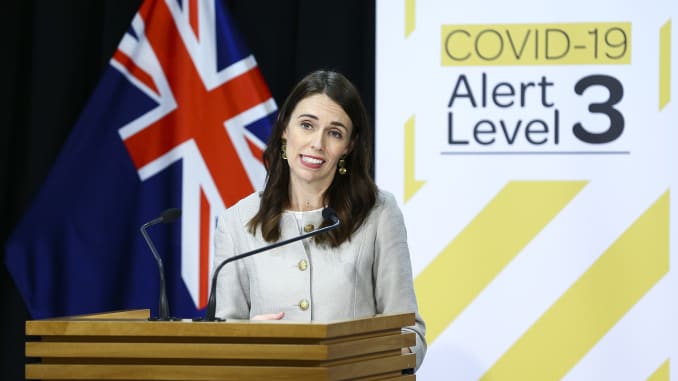
In June 2020, New Zealand’s Prime Minister, Jacinda Ardern, danced to celebrate the end of the COVID-19 pandemic within the country’s borders. While the rest of the world prepares for the ‘second wave’ of the virus the citizens of New Zealand (NZ) have been engaging in a level of normality which is far out of reach for most. In total, the country has had under 2,000 cases, and only 25 deaths (as of 11th November 2020). It is indisputable that, in terms of lives lost, New Zealand has had one of the best COVID-19 responses in the world.
How did New Zealand achieve this?
At the beginning of February, weeks prior to the first confirmed case on New Zealand soil on the 28th of the month, the country began the shutdown of its borders. Arrivals from or via China were banned, while NZ citizens returning from China were required to self-isolate for 14 days upon their arrival. Despite this early, and unprecedented, intervention, Ardern announced that the virus was expected to eventually arrive on the island.
Just over a month later, on 19th March 2020, NZ took the step alongside Australia of shutting its borders to all non-residents. Few other countries took similar steps, and many – such as the UK – continue to allow international arrivals with little enforcement of isolation rules.
New Zealand’s period of nationwide lockdown began on 25th March 2020, when the number of cases stood at only 102 with zero deaths. The measures of full-scale lockdown – known as ‘Alert Level 4’ matches that of other nations with the closure of all barre essential businesses and clear instructions to stay at home. The World Health Organization (WHO) praised NZ for its fast response to COVID by “isolating cases, reducing contact and testing” to eliminate COVID-19. Just 75 days later, on 8th June, the country declared itself to be COVID-19 free and lifted all lockdown restrictions after two weeks without new cases.

Public unity was encouraged by the government surrounding the lockdown with the population being asked to unite as a “team of five million” to protect their community. The success of the short lockdown resulted in the avoidance of the public apathy connected to lockdowns across the world. When surveyed about COVID-19, 84% of New Zealanders approved of how their government was handling the outbreak. Across the G7 nations, this number was an average of just 54%.

Contact tracing began on 19th May 2020 with the introduction of a government-created ‘app’ which Prime Minister Ardern described as a “digital diary” which utilized QR codes to record where citizens have been – much like the UK model. Much like other countries, the launch of this method of contract tracing was not as smooth as anticipated with reports of the app being ‘clunky’ and failing to work on older phones. However, despite these issues by early September 2020, 2.1 million New Zealanders had downloaded the Covid Tracer App – just under 43% of the population.
This number is a significant improvement upon the figures seen in European countries. Around the same period, under 4% of France’s population had downloaded their tracing app, and around 15% of the population of the UK have downloaded NHS track and trace (as of 27th September 2020.)
Alongside contact tracing, NZ implemented a rigorous testing regime in which “tens of thousands” of tests were conducted in some of its largest cities. The government website clearly documents the level of testing taking place and since the start of the pandemic 1,155, 514 tests have been administered in NZ (as of November 12th, 2020).

New Zealand’s response to COVID-19 has been one characterized by efficiency, and stability in the choices announced by the government. However, there have been issues that need to be acknowledged.
‘Bumps’ along the way?
Just 9 days after declaring itself to be COVID-19 free, New Zealand found itself to be dealing with two infected British women being allowed to leave quarantine without being tested. Prime Minister Jacinda Ardern stated that it was an “unacceptable failure” on behalf of health officials who allowed the women a compassionate exemption from isolation without testing them first.
This was an embarrassing turn for the New Zealand government after an almost flawless COVID-policy run prior to this event. Despite this, in August the government was still able to credibly mark 100 days without community COVID-19 transmission in the country.
The Economy
Much like the rest of the world, New Zealand is currently facing a recession following its national lockdown. Between April and June, the country’s GDP shrank by 12.2%, placing the country into its worst recession since 1987.
When surveyed about personal income, 74% of those who answered said COVID-19 already had, or they expected it would affect their personal income. Similarly, 80% stated that their household income had also been, or expected it would be, affected. Across the G7 countries, these figures were 71% and 70% respectively with the category of income already having been impacted considerably lower than New Zealand’s numbers.


In response to the hardships being felt by their citizens, the Prime Minister, and her ministers, took a 20% pay cut in solidarity with those suffering financially during the pandemic.
Despite the economic downturn, a Bloomberg Media survey ranked as the best country in terms of political stability, economic recovery, virus control, and social resilience following COVID-19. This has created hope for a swift economic recovery for New Zealand, with UK financial experts stating that the country will be more favourable for investors.
Where are they now?
New Zealand faced a small second wave of COVID-19 but was quick to declare themselves free of the virus once again on 7th October 2020. Despite this, as of 12th November 2020, there are 53 active cases in the country – with this number including 47 on the border. The low number of community cases – which currently stands at 6 – gives hope that COVID-19 will not once again spread within the country.
Jacinda Ardern’s Labour Party stayed in power following the 17th October 2020 election where they won a massive 49.1% of the votes. This was a clear indication of public approval of the government’s handling of the pandemic.
New Zealand is unarguably in a better place than the majority of the world. Their response to COVID-19 was consistent and effective at removing the virus from their shores. It is unclear as of yet when the country will fully re-open its borders, but with a second wave taking hold across the globe it is unlikely anyone will be heading off for a New Zealand holiday with ease anytime soon.



Average Rating